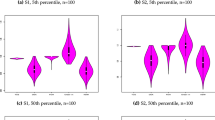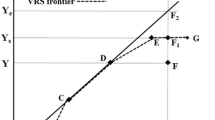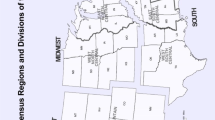Abstract
The purpose of this paper is to measure and explain variations in productive efficiency of municipal governments in Belgium. Technical efficiency is evaluated using a non-parametric method based on the Free Disposal Hull (FDH) reference technology. We first calculate input, output, and graph Farrell efficiency measures for a cross-section of all 589 Belgian municipalities. In a second stage of the analysis we explain the calculated differences in efficiency in terms of variables related to the structural characteristics of municipalities and to the institutional environment.
Similar content being viewed by others
References
Atkinson, S. and Halvorsen R. (1986). The relative efficiency of public and private firms in a regulated environment: The case of U.S. Electric Utilities.Journal of Public Economics 29(3): 281–294.
Bartel, R. and Schneider, F. (1991). The “Mess” of the public industrial production in Austria: A typical case of public sector inefficiency?Public Choice 68(1–3): 17–40.
Boardman, A. and Vining, A. (1989). Ownership and performance in competitive environments: A comparison of the performance of private, mixed, and state-owned enterprises.Journal of Law and Economics 32(1): 1–33.
Borcherding, T.E., Pommerehne, W.W. and Schneider, F. (1982). Comparing the efficiency of private and public production: The evidence from five countries.Zeitschrift für Nationalökonomie 42(S2): 127–156.
De Borger, B., Kerstens, K., Moesen, W. and Vanneste, J. (1992).A non-parametric non-convex approach to technical efficiency. University of Antwerp (SESO-report 92/276).
De Grauwe, P. (1985).The growth of the public sector in Belgium under center-right and center-left governments. Leuven (KUL, CES-Research Paper 49).
Deller, S.C. (1992). Production efficiency in local government: a parametric approach.Public Finance 47(1): 32–44.
Deprins, D., Simar, L. and Tulkens, H. (1984). Measuring labor-efficiency in post offices. In M. Marchand, e.a. (Eds.),The performance of public enterprises: concepts and measurement, 243–267. Amsterdam: Elsevier.
Färe, R., Grosskopf, S. and Lovell, C. (1985).The measurement of efficiency of production. Boston: Kluwer.
Färe, R., Grosskopf, S. and Logan, J. (1985). The relative performance of publicly-owned and privately-owned electric utilities.Journal of Public Economics 26(1): 89–106.
Farrell, M. (1957). The measurement of productive efficiency.Journal of the Royal Statistical Society 120 (Series A): 253–290.
Fisk, D. (1983).Measuring productivity in state and local government. Washington: U.S. Government Printing Office.
Førsund, F., Lovell, C. and Schmidt, P. (1980). A survey of frontier production functions and of their relationship to efficiency measurement.Journal of Econometrics 13(1): 5–25.
Hamilton, B.W. (1983). The flypaper effect and other anomalies.Journal of Public Economics 22(2–3): 347–361.
Hayes, K. and Chang, S. (1990). The relative efficiency of city manager and mayor-council forms of government.Southern Economic Journal 57(1): 167–177.
Hulten, C. (1984). Productivity change in state and local governments.Review of Economics and Statistics 66(2): 256–266.
Levitt, M. and Joyce, M. (1987).The growth and efficiency of public spending. Cambridge: Cambridge University Press.
Lovell, C.A.K. (1992). Production frontiers and productive efficiency. In Fried, Lovell and Schmidt (Eds.),The measurement of productive efficiency: Techniques and Applications, Oxford, Oxford University Press.
Lovell, C., Walters, L. and Wood, L. (1990).Stratified models of education production using DEA and regression analysis. Working paper 90-5. Department of Economics, Univ. of North Carolina.
Martin, J. and Page, J. (1983). The impact of subsidies on X-efficiency in LDC industry: theory and an empirical test.Review of Economics and Statistics 55(4): 608–617.
McDonald, J. and Moffitt, R. (1980). The uses of tobit analysis.Review of Economics and Statistics 62(2): 318–321.
Mueller, D. (1989).Public choice II. Cambridge: Cambridge University Press.
Niskanen, W.A. (1974).Bureaucracy and representative government. Chicago: Aldine.
Pestieau, P. and Tulkens, H. (1990).Assessing the performance of public sector activities: some recent evidence from the productive efficiency viewpoint. CORE-discussion paper 9060. Louvain-la-Neuve: U.C.L.
Pudney, S. (1989).Modelling individual choice: the econometrics of corners, kinks, and holes. Oxford: Basil Blackwell.
Rhodes, E. and Southwick, L. (1989).Comparison of university performance differences over time. Working Paper. School of Public and Environmental Affairs, Indiana University.
Russell, R. (1988). On the axiomatic approach to the measurement of technical efficiency. In W. Eichhorn (Ed.),Measurement in economics, 207–217. Heidelberg: Physica-Verlag.
Ruud, P.A. (1984). Tests of specification in econometrics.Econometric Reviews 3: 211–242.
Schwab, R.M. and Oates, W.E. (1991). Community composition and the provision of local public goods.Journal of Public Economics 44(2): 217–237.
Seiford, L. and Thrall, R. (1990). Recent developments in DEA: the mathematical programming approach to frontier analysis.Journal of Econometrics 46(1–2): 7–38.
Silkman, R. and Young, D.R. (1982). X-efficiency and state formula grants.National Tax Journal 35(3): 383–397.
Spann, R. (1977). Public versus private provision of governmental services. In T. Borcherding (Ed.),Budgets and bureaucrats: the sources of government growth, 71–89. Durham: Duke U.P.
Tulkens, H. (1990).Non-parametric efficiency analyses in four service activities: retail banking, municipalities, courts and urban transit. CORE-discussion paper 9050. Louvain-la-Neuve, U.C.L.
Vanden Eeckaut, P., Tulkens, H. and Jamar, M. (1991).A study of cost-efficiency and returns to scale for 235 municipalities in Belgium. CORE-discussion paper 9158. Louvain-la-Neuve, U.C.L.
Zieschang, K. (1984). An extended Farrell technical efficiency measure,Journal of Economic Theory 33(2): 387–396.
Author information
Authors and Affiliations
Rights and permissions
About this article
Cite this article
de Borger, B., Kerstens, K., Moesen, W. et al. Explaining differences in productive efficiency: An application to Belgian municipalities. Public Choice 80, 339–358 (1994). https://doi.org/10.1007/BF01053225
Accepted:
Issue Date:
DOI: https://doi.org/10.1007/BF01053225




